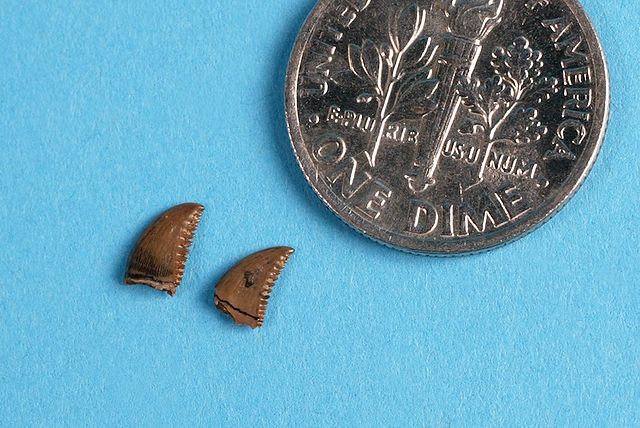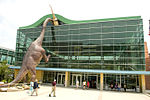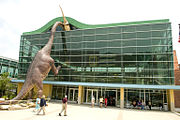
File:The Childrens Museum of Indianapolis - Troodon teeth.jpg

| |
This is a file from the Wikimedia Commons. Information from its description page there is shown below.
Commons is a freely licensed media file repository. You can help. |
 |
This image has currency in it to indicate scale. Avoid using objects such as coins for scale, as they will require people unfamiliar with them to look up the dimensions or guess, both of which defeat the purpose of the object in the first place. Coins are particularly bad as they can reinforce a geographical bias, and some coins' designs are copyrighted. Ideally, a photograph should include a ruler with the subject (as seen in this photo) or add a scale marking via an image editor instead (as seen in this photo). SI ("metric") units are the most commonly used worldwide (see metre, 1 E-2 m). Examples of bad practice: here. |
|
Common coin diameters for reference:
|
|
|
|
| Description | Troodon teeth (Troodon formosus) in the permanent collection of The Children’s Museum of Indianapolis | ||||||||||||||
| Date | 65 mya | ||||||||||||||
| Current location |
|
||||||||||||||
| Accession number | 2003.93.3 | ||||||||||||||
| Object history | “These teeth come from a dinosaur known as Troodon that lived during the Late Cretaceous Period (65 million years ago.). Paleontologists think that Troodon was a swift dinosaur, with sickle shaped claws, serrated teeth and a great deal of intelligence – making it a formidable carnivore for its size. (It was about 3 feet tall.) These shed teeth were found among the bones of several duckbill dinosaurs in the badlands of South Dakota.” The Children’s Museum of Indianapolis, IMCPL Digital Collections | ||||||||||||||
| References | Artifact description: Artifacts at the Children’s Museum of Indianapolis, Indianapolis Marion County Public Library, IMCPL Digital Collections | ||||||||||||||
| Source/Photographer | Wendy Kaveney | ||||||||||||||
| Permission ( Reusing this file) |
See license | ||||||||||||||
 |
This image was provided to Wikimedia Commons by The Children's Museum of Indianapolis as part of an ongoing cooperative project. The artifact represented in the image is part of the permanent collection of The Children’s Museum of Indianapolis.
|
| This file is licensed under the Creative Commons Attribution-Share Alike 3.0 Unported license. | ||
| Attribution: The Children's Museum of Indianapolis | ||
http://creativecommons.org/licenses/by-sa/3.0 CC-BY-SA-3.0 Creative Commons Attribution-Share Alike 3.0 truetrue |
File usage
Metadata
| Camera manufacturer | Canon |
|---|---|
| Camera model | Canon EOS-1D |
| Copyright holder | Photo by Debbie Winchester |
| Exposure time | 1/842,018,834 sec (1.1876218911274E-9) |
| F-number | f/1.1591355599214 |
| ISO speed rating | 200 |
| Date and time of data generation | 4:11:12 |
| Lens focal length | 0 mm |
| Orientation | Normal |
| Horizontal resolution | 300 dpi |
| Vertical resolution | 300 dpi |
| Software used | Adobe Photoshop CS Windows |
| File change date and time | 14:37, 28 February 2004 |
| Exposure Program | Manual |
| Exif version | 2.1 |
| Date and time of digitizing | 4:11:12 |
| Shutter speed | 2,147,483,647 |
| APEX aperture | 0.02 |
| Exposure bias | 2,147,483,647 |
| Metering mode | Pattern |
| Flash | Flash did not fire |
| Colour space | sRGB |
Find out more
SOS Children has brought Wikipedia to the classroom. SOS Children's Villages believes that a decent childhood is essential to a happy, healthy. Our community work brings families new opportunities through education, healthcare and all manner of support. Why not try to find out more about sponsoring a child?


